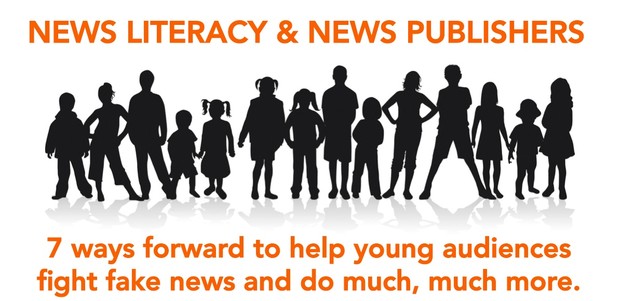This is the fourth installment of a WAN-IFRA Youth & News Media series about news literacy initiatives around the world (outside the United States) that have been created by or could involve news publishers. It was commissi![]() oned by the American Press Institute. Lead author is Aralynn McMane.
oned by the American Press Institute. Lead author is Aralynn McMane.
INSTALLMENTS OF THE REPORT
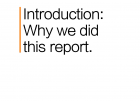 |
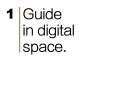 |
 |
 |
 |
 |
 |
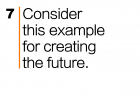 |
#4 PROMOTE ENCOUNTERS WITH JOURNALISTS: Encourage face-to-face contact that benefits both young people and journalists.
 G.B. Trudeau. Used by permission of Universal Uclick. All rights reserved. db900608-LT.full.jpg) DOONESBURY © (1990) G.B. Trudeau. Used by permission of Universal Uclick. All rights reserved.
DOONESBURY © (1990) G.B. Trudeau. Used by permission of Universal Uclick. All rights reserved.
(NOTE: * denotes a WAN-IFRA Center of Youth Engagement Excellence and ** a winner of the WAN-IFRA World Young Reader Prize)
In one Doonesbury cartoon, the journalist character Rick Redfern visits his son's class. In the first panel, he explains that the teacher asked him to come and tell what he does for a living. In the second, he says he's a reporter and writes stories for the local paper. In the third panel, there is silence as the children stare at him. In the last panel, one child asks if it's snack time yet, while Redfern's son Jeff says, "Dad! You're dying! Punch it up!"
It’s easy to get such an encounter wrong. If it is pure lecture and not a conversation, the result can be deadly. That was the exactly the scene at a recent session at one newspaper in Europe in which students got hear two top news executives and even sit in on a news meeting. The students asked carefully prepared questions, but the editors never asked them a thing, thus missing out on a truly rare chance for fruitful interaction.
But, if done right, meeting a journalist face-to-face can have a strong impact. Alan Miller of the U.S. based News Literacy Project remembers that when he spoke at his daughter's school about journalism and its purpose, he got 175 handwritten thank-you notes. “I realized that what I had shared with them really resonated," he notes on the project's site. [More about that project in the "Back in the USA" section at the end of this installment].
 For more than 20 years, the Belgian journalists association (AJP) has organized journalist volunteers to speak with students, up to 10 000 each year, about how news works. AJP provides the journalists with a guide (in French) with tips for making such visits a success and materials for teachers to prepare for the visits. www.ajp.be/jec
For more than 20 years, the Belgian journalists association (AJP) has organized journalist volunteers to speak with students, up to 10 000 each year, about how news works. AJP provides the journalists with a guide (in French) with tips for making such visits a success and materials for teachers to prepare for the visits. www.ajp.be/jec
AJP did a survey of 500 teachers to check the usefulness of the effort. "Comments from respondents to the survey are clear," according to Jean-François Dumont, deputy director of the association. "For students, journalists' visits are motivating, interesting but also — it was least expected — rewarding. Young people feel recognized or flattered by the fact that a media professional has taken time to come and speak with them."
For journalists, also, there is a benefit: "I learn a lot thanks to this kind of contact with schools. The students end up describing their passions, their dreams, their lives. It's a real reporting opportunity," said a journalist from the Brussels daily Le Soir.
For AJP, the visits tie closely with the Ouvrir Mon Quotidien (Open my Daily) program of the French-language news publishers association (LAPRESSE.BE)*, in which teachers receive, for free, dailies of their choice for class use during certain periods of the school year. Publishers receive a government grant to fund the distribution. [That project is expected soon to move to a totally digital emphasis.]
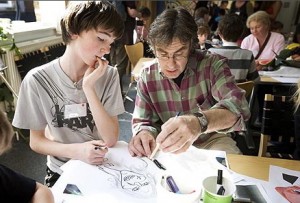 Finland has long had such a program and guide, which WAN-IFRA has adapted for international use [See WAN-IFRA RECOMMENDS at the end of this section.] In France, such visits have always been an integral part of the country's Semaine de la Presse et des médias dans l'école [The Week of Press and Media in School], and has intensified since the Paris killings of journalists in 2015. The newest player is The Guardian** in London, which has begun a pilot outreach program to send journalists into primary school classes. Most sessions are in London but deputy production editor Suzanne Warr did four sessions in Lancashire.
Finland has long had such a program and guide, which WAN-IFRA has adapted for international use [See WAN-IFRA RECOMMENDS at the end of this section.] In France, such visits have always been an integral part of the country's Semaine de la Presse et des médias dans l'école [The Week of Press and Media in School], and has intensified since the Paris killings of journalists in 2015. The newest player is The Guardian** in London, which has begun a pilot outreach program to send journalists into primary school classes. Most sessions are in London but deputy production editor Suzanne Warr did four sessions in Lancashire.
This program joins the publisher’s existing face-to-face encounters to help families learn a journalistic format familiar to all generations, the political cartoon. Children and their parents can attend a Cartoon and Art Family Day that offers a range of talks and workshops with top cartoonists, illustrators and artists. Topics include caricature, cartoon strips, portraiture, learning about the role of political cartoons and overcoming a fear of drawing.
ALSO - http://www.theguardian.com/gnmeducationcentre/gnm-education-centre-families
WAN-IFRA has begun challenging publishers to go further in face-to-face contact by encouraging them to give control over 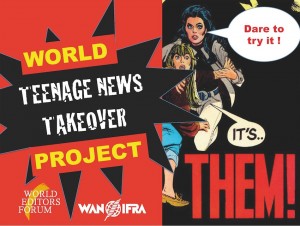 some part of the normal daily content to some group of teenagers during the month of November. This "World Teenage News Takeover" initiative provides a guide that details how publishers in five countries have approached the idea. The level of control varies widely, from just the opinion page to an entire print edition. Editors who have participated in a takeover report a new appreciation of the students by journalists, and the students attest to a new, up-close-and-personal understanding of how hard it can be to get it right when doing news work. For example, Austria’s Kurier (daily circ. 168,040) brought in 13 students for the takeover, starting with the morning meeting to decide the day’s content.
some part of the normal daily content to some group of teenagers during the month of November. This "World Teenage News Takeover" initiative provides a guide that details how publishers in five countries have approached the idea. The level of control varies widely, from just the opinion page to an entire print edition. Editors who have participated in a takeover report a new appreciation of the students by journalists, and the students attest to a new, up-close-and-personal understanding of how hard it can be to get it right when doing news work. For example, Austria’s Kurier (daily circ. 168,040) brought in 13 students for the takeover, starting with the morning meeting to decide the day’s content.
“It is clear to us that this young generation is quite interested in quality content and in the media business,” said the editor, Helmut Brandstätter. The teenagers made that so obvious, in fact, that Brandstätter decided to do monthly takeovers.
Schwäbische Zeitung** also took up the challenge, giving control of a Saturday edition in 2016 to fifteen 14- to 16-year-olds, with satisfying results.
 "A fresh breeze of ideas swept across our newsroom and gave us an insight into the world of young readers," says Hendrik Groth, editor-in-chief. "This experience definitely has an enduring effect on our daily news coverage.” Project manager Jasmin Off reports that the connection will continue through a WhatsApp group. "One reason was to stay in touch with those talented young writers but moreover we now have a platform to discuss our daily products for the print edition as well as our online news coverage," she explained. "The feedback and suggestions of the teenagers are highly valuable." [Video 00:01:02 In German with English subtiltes.] https://www.youtube.com/watch?v=FcZfq4YyQAk
"A fresh breeze of ideas swept across our newsroom and gave us an insight into the world of young readers," says Hendrik Groth, editor-in-chief. "This experience definitely has an enduring effect on our daily news coverage.” Project manager Jasmin Off reports that the connection will continue through a WhatsApp group. "One reason was to stay in touch with those talented young writers but moreover we now have a platform to discuss our daily products for the print edition as well as our online news coverage," she explained. "The feedback and suggestions of the teenagers are highly valuable." [Video 00:01:02 In German with English subtiltes.] https://www.youtube.com/watch?v=FcZfq4YyQAk
More about how to download the guide is in the WAN-IFRA RESOURCES section at the end of this section.
Some publishers keep young people close at hand on a routine basis. This is business as usual for the new editions that target teenagers and children [details in part 6], but much rarer for news publishers targeting a wide age range.
 Kompas** in Indonesia is one of those rare cases. Each year, this quality daily that reports the country’s largest readership offers 36 teenagers the chance to work in the "MUDA" newsroom alongside older journalists. Hundreds of young people apply, and the older journalists find the interaction highly useful. "We can discuss and brainstorm together," says editor Budi Suwarna. "We can hear what they thinking, about their preferences." This video [00:02:56] gives an overview of this and other initiatives that made Kompas the 2015 WAN-IFRA World Young Reader News Publisher of the Year.
Kompas** in Indonesia is one of those rare cases. Each year, this quality daily that reports the country’s largest readership offers 36 teenagers the chance to work in the "MUDA" newsroom alongside older journalists. Hundreds of young people apply, and the older journalists find the interaction highly useful. "We can discuss and brainstorm together," says editor Budi Suwarna. "We can hear what they thinking, about their preferences." This video [00:02:56] gives an overview of this and other initiatives that made Kompas the 2015 WAN-IFRA World Young Reader News Publisher of the Year.
Newsroom interaction with young people has been a decades-long practice for the Brazilian regional daily Zero Hora** (the flagship edition of the RBS Group). Its Rookie Reporter assures strong interaction at a key moment in the lives of a key constituency: journalism students.
Staff travel to all 25 of the region’s journalism schools to talk about the work of a journalist and the future of news media. Students up to age 20 can then submit writing, videos and photojournalism to become one of 15 finalists. The finalists attend a seminar in the Zero Hora offices after which five of them get to continue with more training and hands-on news work. Since its start in 2009, more than 1,200 applications were submitted yielding 25 winners, 20 of which got jobs within the RBS group.
“Rookie Reporter …[gives] us the excellent opportunity to select the best students in the entire state,” said group executive editor Marta Gleich.
 One new player adds an international touch to providing interaction between journalists and young people. News Decoder,** based in Paris, is a not-for-profit news service and global forum to help secondary school and university students learn about international affairs and engage in a borderless conversation via webinars. [Video 00:00:58]
One new player adds an international touch to providing interaction between journalists and young people. News Decoder,** based in Paris, is a not-for-profit news service and global forum to help secondary school and university students learn about international affairs and engage in a borderless conversation via webinars. [Video 00:00:58]
With universities and secondary schools in nine countries, founder Nelson Graves organizes webinars on tough topics. Nine out of ten of the special guests are or were journalists. “We want to create an environment where people can feel free to interact.” [There is no aggregation on the news service. Half the stories are written mostly by former Reuters correspondents and half by students from partner universities, mostly journalism schools.]
Finally, it is the new print and digital youth editions that take most seriously the need to have mindful face-to-face encounters with young people, their audience. Details about those efforts are coming in part 6 of this report: Explore the new news for kids.
BACK IN THE USA
This report was specifically commissioned to concentrate on initiatives outside the United States, but we would be shirking our task if we did not give you at least one solid U.S. example.
 NY1 News television anchor and reporter Cheryl Wills leads 5th grade history students at George Jackson Academy in New York City through the part of the “Journalist Telephone” exercise that explores how word-of-mouth information changes each time it is passed along. Photos by Meredith W. Goncalves
NY1 News television anchor and reporter Cheryl Wills leads 5th grade history students at George Jackson Academy in New York City through the part of the “Journalist Telephone” exercise that explores how word-of-mouth information changes each time it is passed along. Photos by Meredith W. Goncalves
THE NEWS LITERACY PROJECT -- The news literacy field has two U.S. journalists to thank for creating early, solid and practical programs. Howard Schneider became founding dean for Stony Brook University’s journalism school after leaving his post as editor of Newsday and established the Center for News Literacy in 2007. For lower grades, Alan Miller, a Pulitzer Prize-winning investigative reporter for the Los Angeles Times, beganThe News Literacy Project in 2008, targeting upper primary and secondary schools.
The News Literacy Project (NLP) counts on both face-to-face and virtual encounters between students and journalists as a core part of its strategy.
 Its new checkology™ virtual classroom augments the work of the more than 400 volunteer journalist fellows who are enrolled in the News Literacy Project’sonline directory. In the past seven years, they have collectively delivered more than 750 lessons in person and virtually with a major impact on NLP’s growth and impact. [Video 00:01:23]
Its new checkology™ virtual classroom augments the work of the more than 400 volunteer journalist fellows who are enrolled in the News Literacy Project’sonline directory. In the past seven years, they have collectively delivered more than 750 lessons in person and virtually with a major impact on NLP’s growth and impact. [Video 00:01:23]
“This is one of the things that makes NLP unique,” Miller says.
Reporters, editors and producers help U.S. middle school (early teens) and high school students (mid-teens to age 18) understand that all information is not created equal and to learn the standards and accountability that distinguishes quality journalism from the other information and images that students encounter through online searches and social media.
“The journalists have given these teenagers the tools to be more skeptical, better informed and more engaged consumers and creators as students and citizens,” Miller explains.
He says the program has contributed to “peeling back the curtain on the newsgathering process.” This has “demystified the news for students so that they feel empowered to interact with news organizations, whether by submitting a correction, sending a letter to the editor, posting a comment or tweeting at a journalist.”
Journalists from organizations including The New York Times, The Wall Street Journal, The Washington Post, NBC News and BuzzFeed act as virtual teachers in NLP’s checkology™ virtual classroom, which has vastly extended the project’s worldwide reach. Teachers can opt for the free basic service or a premium edition with more interactivity.
Since the platform’s launch in May 2016, more than 6,000 educators who teach more than 600,000 students in every state in the U.S. and 44 countries have registered to use it. “Teachers and students cite the value of these real-world instructors as one of the virtual classroom’s appeals,” Miller says.
NPR, U.S. National Public Radio, did piece that does a good job of explaining how checkology™ works (link and transcript here). Also, click on the photo to see a video about checkology. http://www.checkology.org
WAN-IFRA RECOMMENDS
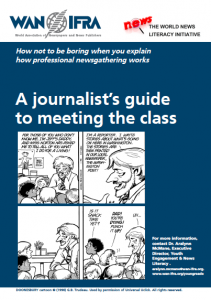 A JOURNALIST’S GUIDE TO MEETING THE CLASS - If properly prepared, a reporter or editor or photographer who visits a class to explain how they make the news can return with ideas from the group they meet. To help news staffers face students with confidence, WAN-OFFERS a free guide to download: A Journalist's guide to meeting the class. It was written for people who work with print editions, but the core information can be useful for any journalist. We ask for contact details to be able to provide updates and potential opportunities for joint action. (Content based from a similar guide by the Finnish Newspapers Association and cover art thanks to cartoonist G.B. Trudeau). You can go directly to the download page here.
A JOURNALIST’S GUIDE TO MEETING THE CLASS - If properly prepared, a reporter or editor or photographer who visits a class to explain how they make the news can return with ideas from the group they meet. To help news staffers face students with confidence, WAN-OFFERS a free guide to download: A Journalist's guide to meeting the class. It was written for people who work with print editions, but the core information can be useful for any journalist. We ask for contact details to be able to provide updates and potential opportunities for joint action. (Content based from a similar guide by the Finnish Newspapers Association and cover art thanks to cartoonist G.B. Trudeau). You can go directly to the download page here.
 HOW TO DO A TEENAGE NEWS TAKEOVER - The World Teenage News Takeover guide offers the experience of five varied newspapers -- with paid circulations ranging from 25 000 to 175 000 -- that could be useful in planning such an effort. For example, you might want first do a survey first, as did The Belfast Telegraph), or a contest first (The West Australian) or approach local companies to become different levels of partners (Frankfurter Neue Presse). We ask for contact details to be able to provide updates and potential opportunities for joint action. You can go directly to the download page here.
HOW TO DO A TEENAGE NEWS TAKEOVER - The World Teenage News Takeover guide offers the experience of five varied newspapers -- with paid circulations ranging from 25 000 to 175 000 -- that could be useful in planning such an effort. For example, you might want first do a survey first, as did The Belfast Telegraph), or a contest first (The West Australian) or approach local companies to become different levels of partners (Frankfurter Neue Presse). We ask for contact details to be able to provide updates and potential opportunities for joint action. You can go directly to the download page here.

